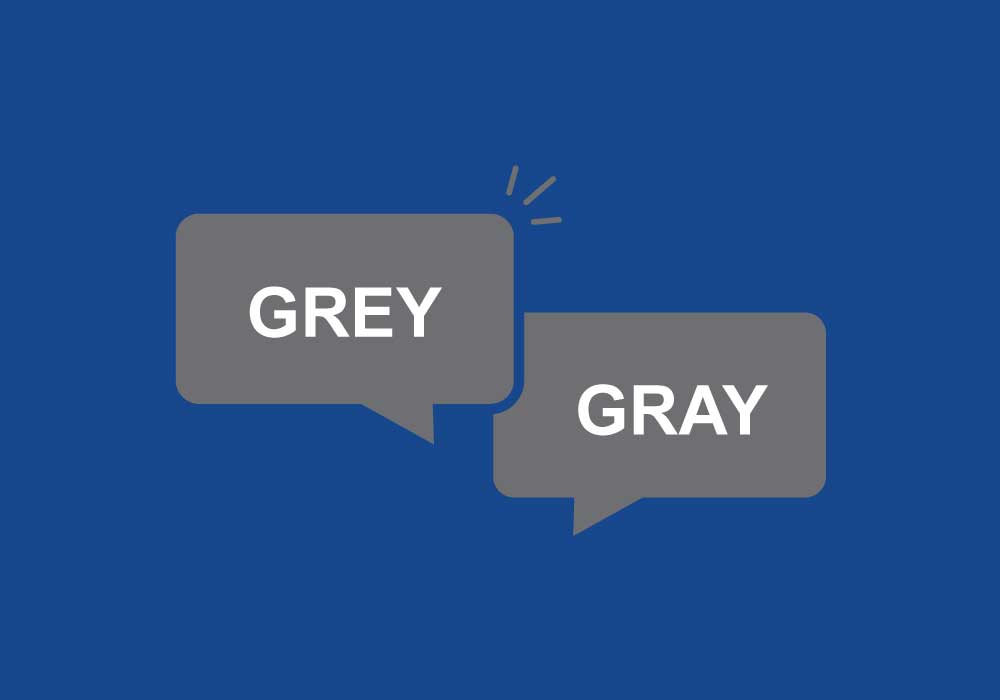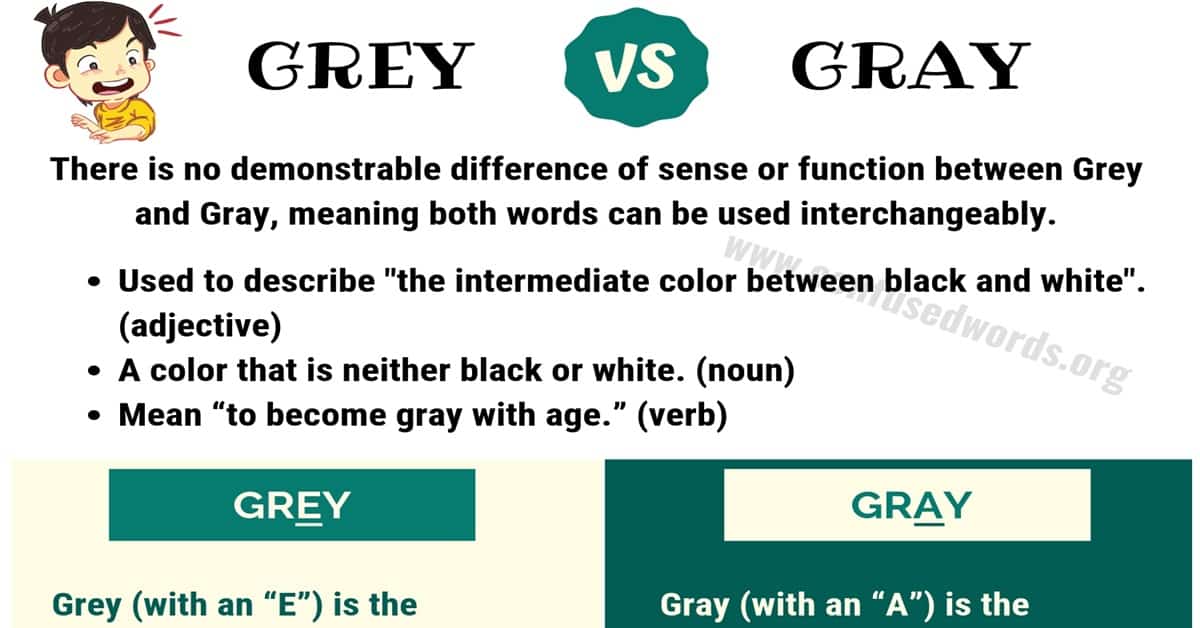Introduction: The Gray vs Grey Conundrum
Gray vs Grey: When it comes to the color that sits comfortably between black and white, the spelling can be a bit confusing. Is it “gray” or “grey”? The answer isn’t as black and white as you might think. Both spellings are correct, but their usage depends on where you are in the world and the context in which you’re writing. This article will delve into the nuances of “gray vs grey,” exploring their differences, origins, and when to use each spelling. Whether you’re a writer, a student, or just someone who loves the English language, this guide will help you navigate the gray (or grey) areas of this fascinating topic.
The Basics: Gray vs Grey Color
At its core, “gray” and “grey” refer to the same color—a neutral shade that blends black and white. The difference lies in the spelling, which is influenced by regional preferences. In American English, “gray” is the more commonly used spelling, while “grey” is preferred in British English and other English-speaking countries like Canada, Australia, and South Africa. This distinction is similar to other American vs British spelling differences, such as “color” vs “colour” or “theater” vs “theatre.”
The color itself has a rich history and cultural significance. Gray is often associated with neutrality, balance, and sophistication. It’s a color that can evoke feelings of calm and stability, but it can also be seen as dull or depressing, depending on the context. In fashion, gray is a timeless color that pairs well with almost anything, making it a staple in many wardrobes. In nature, gray can be found in the fur of animals, the bark of trees, and the stones that make up our landscapes.
The Spelling Debate: Gray vs Grey Spelling
The spelling difference between “gray” and “grey” is one of the most well-known examples of how American and British English diverge. But why do these differences exist? The answer lies in the history of the English language and the influence of lexicographers like Noah Webster, who sought to simplify and standardize American English in the 19th century. Webster’s dictionary, first published in 1828, favored the spelling “gray,” which has since become the standard in the United States.
In contrast, “grey” has remained the preferred spelling in the UK and other Commonwealth countries. This spelling is also closer to the word’s Old English origins, where it was spelled “grǣg.” Over time, as English evolved and spread across the globe, regional variations in spelling emerged, leading to the differences we see today.
It’s worth noting that while “gray” is more common in American English, “grey” is not entirely absent. You might still see “grey” used in certain contexts, such as brand names (e.g., Grey Goose vodka) or cultural references (e.g., the TV show “Grey’s Anatomy”). Similarly, in British English, “gray” is occasionally used, particularly in scientific or technical contexts.
The History of Gray and Grey

The word “gray” (or “grey”) has a long and fascinating history. It derives from the Proto-Germanic root *grewa-, which also means “gray.” The word entered Old English as “græg,” and both spellings—gray and grey—were used interchangeably in England for centuries. Over time, “grey” became the more popular spelling in the UK, while “gray” gained traction in the United States.
One interesting historical note is the use of “gray” during the American Civil War. Southern troops were often referred to as “Grays,” a term that distinguished them from the “Blues” of the Union army. This usage has persisted in historical contexts, where “Grays” is the preferred spelling when referring to Confederate soldiers.
In literature, both spellings have been used by famous authors. For example, Louisa May Alcott, an American author, used “gray” in her classic novel “Little Women,” while British author W. Somerset Maugham used “grey” in “The Moon and Sixpence.” These examples highlight the regional preferences that have shaped the spelling of this versatile color.
When Spelling Matters: Gray vs Grey Difference
While the difference between “gray” and “grey” is often a matter of regional preference, there are times when spelling matters. Certain words and terms must be spelled a specific way, regardless of whether you’re using American or British English.
For example, the dog breed known for its racing abilities is always spelled “greyhound,” even in American English. This spelling is derived from an Old English word, “grīghund,” which has a different etymology than the color “grey.” Similarly, the unit used to measure radiation absorption is spelled “gray” (Gy), and the fish species known as “grayling” must also be spelled with an “a.”
In some cases, the spelling can change the meaning of a word entirely. For instance, “gray” can refer to the color, while “grey” might be used in a brand name or title, such as “Fifty Shades of Grey.” In these instances, it’s important to pay attention to the context and use the correct spelling to avoid confusion.
Gray vs Grey in Popular Culture
The spelling of “gray” and “grey” has also made its way into popular culture, often playing on the dual spellings for creative effect. For example, the TV show “Grey’s Anatomy” uses the British spelling, even though it’s an American production. The title is a play on the name of the main character, Dr. Meredith Grey, and the anatomical term “gray matter,” which refers to the brain’s neural tissue.
Similarly, the erotic novel series “Fifty Shades of Grey” by British author E. L. James uses the British spelling, which has become iconic in its own right. The title plays on the idea of exploring the “grey areas” of human desire and relationships, making the spelling an integral part of the brand.
In the world of food and drink, the spelling “grey” is often used in brand names to evoke a sense of sophistication or European flair. For example, Grey Poupon mustard and Grey Goose vodka both use the British spelling, even though they are popular in the United States. These examples show how the spelling of “gray” and “grey” can be used strategically to create a specific image or appeal to a particular audience.
Gray vs Grey in Science and Nature
In the scientific community, the spelling of “gray” and “grey” can vary depending on the context. For example, the term “gray matter” refers to the neural tissue in the brain and spinal cord, and it is typically spelled with an “a” in American English. However, in British English, you might see it spelled as “grey matter.”
Similarly, the gray wolf, a species native to North America, is spelled with an “a” in American English, while the grey wolf, found in Europe and Asia, is spelled with an “e.” These differences reflect the regional variations in spelling and highlight the importance of paying attention to context when using these terms.
In nature, the color gray (or grey) is ubiquitous. It can be found in the fur of animals like the gray squirrel, the feathers of birds like the grey heron, and the scales of fish like the grey mullet. The color is also prevalent in the natural landscape, from the gray rocks of mountain ranges to the grey skies of a cloudy day. Whether you spell it with an “a” or an “e,” the color gray/grey is an essential part of the natural world.
Gray vs Grey in Fashion and Design
In the world of fashion and design, the color gray (or grey) is a timeless and versatile choice. It’s a neutral color that pairs well with almost any other color, making it a popular choice for clothing, home decor, and graphic design. Whether you prefer the cool undertones of a light gray or the warm richness of a charcoal grey, this color can create a sophisticated and elegant look.
In fashion, gray is often associated with professionalism and formality. A well-tailored gray suit is a classic choice for business attire, while a grey sweater can add a touch of understated elegance to a casual outfit. In home decor, gray walls can create a calming and neutral backdrop for colorful accents, while grey furniture can add a modern and sleek touch to any room.
The spelling of “gray” and “grey” can also play a role in branding and marketing. For example, a fashion brand might choose to use the British spelling “grey” to evoke a sense of European sophistication, while an American brand might opt for “gray” to appeal to a domestic audience. Regardless of the spelling, the color gray/grey is a versatile and timeless choice that will never go out of style.
Gray vs Grey in Language and Literature
The spelling of “gray” and “grey” has also made its mark on language and literature. As mentioned earlier, both spellings have been used by famous authors, and the choice of spelling can reflect the author’s regional background or the setting of the story. For example, an American author might use “gray” to describe the color of a character’s eyes, while a British author might use “grey.”
In poetry, the spelling of “gray” and “grey” can also play a role in the rhythm and flow of the verse. For example, the word “grey” has one more letter than “gray,” which can affect the syllable count and the overall meter of the poem. Similarly, the choice of spelling can influence the tone and mood of the poem, with “grey” often evoking a more somber or melancholic feeling.
In addition to literature, the spelling of “gray” and “grey” can also be found in idiomatic expressions and phrases. For example, the phrase “gray area” (or “grey area”) refers to a situation that is not clearly defined or is open to interpretation. This phrase is often used in legal, ethical, or moral contexts, where the boundaries between right and wrong are not always clear.
Gray vs Grey in Technology and Innovation
In the world of technology and innovation, the color gray (or grey) is often associated with sleek, modern design. Many tech products, from smartphones to laptops, are available in shades of gray, which convey a sense of sophistication and cutting-edge technology. The spelling of “gray” and “grey” can also play a role in branding and marketing, with companies choosing the spelling that best aligns with their target audience.
For example, a tech company based in the United States might use the spelling “gray” in its product names and marketing materials, while a company based in the UK might opt for “grey.” This choice can help the company connect with its audience and create a cohesive brand identity.
In addition to branding, the spelling of “gray” and “grey” can also be found in technical terms and jargon. For example, the term “gray code” (or “grey code”) refers to a binary numeral system used in digital communications and electronics. This system is designed to minimize errors in digital signals, making it an essential tool in the world of technology and innovation.
Gray vs Grey in Art and Creativity
In the world of art and creativity, the color gray (or grey) is often used to create depth, contrast, and mood. Artists use shades of gray to add dimension to their work, whether they’re painting a landscape, sketching a portrait, or designing a graphic. The spelling of “gray” and “grey” can also play a role in the creative process, with artists choosing the spelling that best reflects their vision and style.
For example, a painter might use the spelling “grey” to evoke a sense of nostalgia or melancholy, while a graphic designer might use “gray” to create a modern and minimalist look. The choice of spelling can also influence the way the audience perceives the artwork, with “grey” often associated with a more traditional or classic aesthetic, and “gray” with a more contemporary or innovative approach.
In addition to visual art, the spelling of “gray” and “grey” can also be found in literature, music, and other forms of creative expression. For example, a songwriter might use the word “grey” in a lyric to convey a sense of ambiguity or uncertainty, while a poet might use “gray” to describe the color of the sky on a cloudy day. Regardless of the medium, the color gray/grey is a powerful tool for artists and creators to express their ideas and emotions.
Gray vs Grey in Everyday Life
In everyday life, the color gray (or grey) is all around us. From the clothes we wear to the cars we drive, this versatile color is a staple in our daily lives. The spelling of “gray” and “grey” can also play a role in how we communicate and express ourselves, whether we’re writing an email, posting on social media, or having a conversation with a friend.
For example, if you’re an American writing an email to a colleague, you might use the spelling “gray” to describe the color of a new product. However, if you’re a British expat living in the United States, you might prefer to use “grey” to maintain a connection to your cultural heritage. Similarly, if you’re a student writing an essay for a British university, you would use “grey” to adhere to the conventions of British English.
In addition to written communication, the spelling of “gray” and “grey” can also influence our perception of the world around us. For example, if you’re reading a book by a British author, you might notice the use of “grey” to describe the color of the sky or the fur of a cat. This subtle difference in spelling can add a layer of authenticity to the story and help you connect with the author’s perspective.
Gray vs Grey in Global Communication
In today’s globalized world, the spelling of “gray” and “grey” can sometimes lead to confusion, especially in international communication. For example, if you’re an American working with a British client, you might use the spelling “gray” in your emails, while your client uses “grey.” This difference in spelling can sometimes lead to misunderstandings, especially if the context is not clear.
To avoid confusion, it’s important to be aware of the regional preferences for “gray” and “grey” and to adapt your spelling accordingly. If you’re unsure which spelling to use, it’s always a good idea to check the style guide or dictionary that is appropriate for your audience. For example, if you’re writing for an American audience, you would use “gray,” while if you’re writing for a British audience, you would use “grey.”
In addition to written communication, the spelling of “gray” and “grey” can also play a role in spoken language. For example, if you’re giving a presentation to an international audience, you might need to clarify which spelling you’re using to avoid confusion. This is especially important in technical or scientific contexts, where the spelling of a term can have a specific meaning or connotation.
Gray vs Grey in Branding and Marketing
In the world of branding and marketing, the spelling of “gray” and “grey” can be a strategic choice that influences how a product or company is perceived. For example, a luxury brand might use the spelling “grey” to evoke a sense of European sophistication, while a tech company might use “gray” to convey a modern and innovative image.
The choice of spelling can also play a role in the naming of products and services. For example, a car manufacturer might name a new model “Gray Wolf” to appeal to an American audience, while a fashion brand might name a new line of clothing “Grey Collection” to target a British market. These subtle differences in spelling can help a brand connect with its target audience and create a cohesive brand identity.
In addition to product names, the spelling of “gray” and “grey” can also be found in advertising and marketing materials. For example, a company might use the spelling “gray” in its American advertisements, while using “grey” in its British campaigns. This attention to detail can help a brand resonate with its audience and create a consistent brand image across different markets.
Gray vs Grey in Education and Learning
In the world of education and learning, the spelling of “gray” and “grey” can be a topic of discussion in English language classes. Teachers might use the difference between “gray” and “grey” as an example of how spelling can vary between American and British English. This can help students understand the importance of regional variations in language and how they can affect communication.
For example, a teacher might ask students to write a short story using the spelling “gray” or “grey,” depending on whether they’re learning American or British English. This exercise can help students practice their spelling and grammar skills while also learning about the cultural and historical factors that influence language.
In addition to classroom activities, the spelling of “gray” and “grey” can also be found in textbooks and educational materials. For example, an American textbook might use the spelling “gray” to describe the color of a historical artifact, while a British textbook might use “grey.” These differences in spelling can help students become more aware of the diversity of the English language and how it varies across different regions.
Gray vs Grey in Social Media and Online Communication
In the age of social media and online communication, the spelling of “gray” and “grey” can sometimes lead to confusion, especially when people from different parts of the world interact online. For example, if you’re an American posting on a British forum, you might use the spelling “gray,” while other users might use “grey.” This difference in spelling can sometimes lead to misunderstandings, especially if the context is not clear.
To avoid confusion, it’s important to be aware of the regional preferences for “gray” and “grey” and to adapt your spelling accordingly. If you’re unsure which spelling to use, it’s always a good idea to check the style guide or dictionary that is appropriate for your audience. For example, if you’re posting on an American social media platform, you would use “gray,” while if you’re posting on a British platform, you would use “grey.”
In addition to written communication, the spelling of “gray” and “grey” can also play a role in online branding and marketing. For example, a company might use the spelling “gray” in its American social media posts, while using “grey” in its British posts. This attention to detail can help a brand connect with its audience and create a consistent brand image across different platforms.
Gray vs Grey in Literature and Storytelling
In literature and storytelling, the spelling of “gray” and “grey” can be a subtle but important detail that adds depth and authenticity to a story. For example, if you’re writing a historical novel set in Victorian England, you might use the spelling “grey” to reflect the language and culture of the time. Similarly, if you’re writing a contemporary novel set in New York City, you might use “gray” to align with American English.
The choice of spelling can also influence the tone and mood of a story. For example, the word “grey” might evoke a sense of nostalgia or melancholy, while “gray” might convey a more modern or neutral feeling. These subtle differences in spelling can help an author create a specific atmosphere and connect with their readers on a deeper level.
In addition to novels and short stories, the spelling of “gray” and “grey” can also be found in poetry, plays, and other forms of literature. For example, a poet might use the word “grey” to describe the color of the sky in a somber poem



